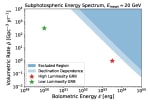Our sun shines not only in light but also in neutrinos. These tiny, chargeless, and nearly massless particles are produced deep in the sun’s core, but we also expect them to be created in the solar atmosphere, either by collisions of cosmic rays or during solar flares. The IceCube Neutrino Observatory at the South Pole, a […]
Research
New algorithm improves IceCube’s pointing accuracy
When the IceCube Neutrino Observatory sees a high-energy neutrino from outer space, IceCube researchers want to know where it came from. The unconventional “telescope” uses a three-dimensional grid of supersensitive light sensors buried under the ice at the South Pole to detect signals from these tiny, nearly massless fundamental particles, which rarely interact and can […]
IceCube detection of a high-energy particle proves 60-year-old theory
On December 8, 2016,* a high-energy particle called an electron antineutrino hurtled to Earth from outer space at close to the speed of light carrying 6.3 petaelectronvolts (PeV) of energy. Deep inside the ice sheet at the South Pole, it smashed into an electron and produced a particle that quickly decayed into a shower of […]
Neutrino astronomy and glaciology meet at IceCube’s Polar Science Workshop
The IceCube Neutrino Observatory has a uniquely close relationship with ice. The telescope needs ice—and a lot of it—to detect the astrophysical neutrinos it was built to study. In fact, most of IceCube’s instruments are embedded in a cubic kilometer of ice at the South Pole. Construction of the detector required drilling 2.5 kilometers straight […]
IceCube pipeline responds quickly to transient phenomena reported by other observatories
The IceCube Neutrino Observatory, an array of over 5,000 light sensors embedded in a cubic-kilometer of ice at the South Pole, was built to detect astrophysical neutrinos: mysterious and nearly massless particles that carry information about the most energetic events in the cosmos. Every time IceCube sees something that might be a cosmic neutrino, it […]
New IceCube analysis sets upper limits on time-dependent neutrino sources
The IceCube Collaboration searches for neutrino sources using a variety of analysis methods. In a paper submitted yesterday to The Astrophysical Journal, the collaboration describes a time-dependent all-sky scan using five years of IceCube data as well as a specific analysis of blazar 3C 279. The analyses did not reveal any new neutrino point sources. […]
Can a high-energy neutrino detector see low-energy neutrinos?
In a paper submitted recently to JCAP, the IceCube Collaboration describes a search for sub-TeV neutrino emission from astrophysical “transient” sources. This is the first transient result from IceCube to use all neutrino flavors in the 1-100 GeV energy region. In the absence of any observed sources in three years of archival IceCube data, the researchers established new limits on the volumetric rate of transients. […]
IceCube performs new measurement of all-flavor neutrino cross section
The number of neutrinos that IceCube detects is dependent on many factors, including the “neutrino cross section”: how likely it is for neutrinos to interact with nuclei in the ice. In a paper submitted today to Physical Review D, the IceCube Collaboration reports a new cross section measurement obtained by using 7.5 years of IceCube data. This is the first such measurement to incorporate all three neutrino flavors. […]
Searching for transient neutrino sources with the help of gamma rays
In a paper submitted today to The Astrophysical Journal, the AMON team, together with the IceCube and HAWC collaborations, present the analysis approach that they developed and reveal the first results from their analysis, as applied to three years of archival data from 2015 to 2018. During those three years, they identified two coincident events that met their criteria for distribution as a public alert, but there were no particularly important astronomical sources seen near either position. […]
IceCube-Gen2 will open a new window on the universe
In a white paper recently submitted to the Journal of Physics G, the international IceCube-Gen2 Collaboration outlines the need for and design of a next-generation extension of IceCube. By adding new optical and radio instruments to the existing detector, IceCube-Gen2 will increase the annual rate of cosmic neutrino observations by an order of magnitude, and its sensitivity to point sources will increase to five times that of IceCube. […]









